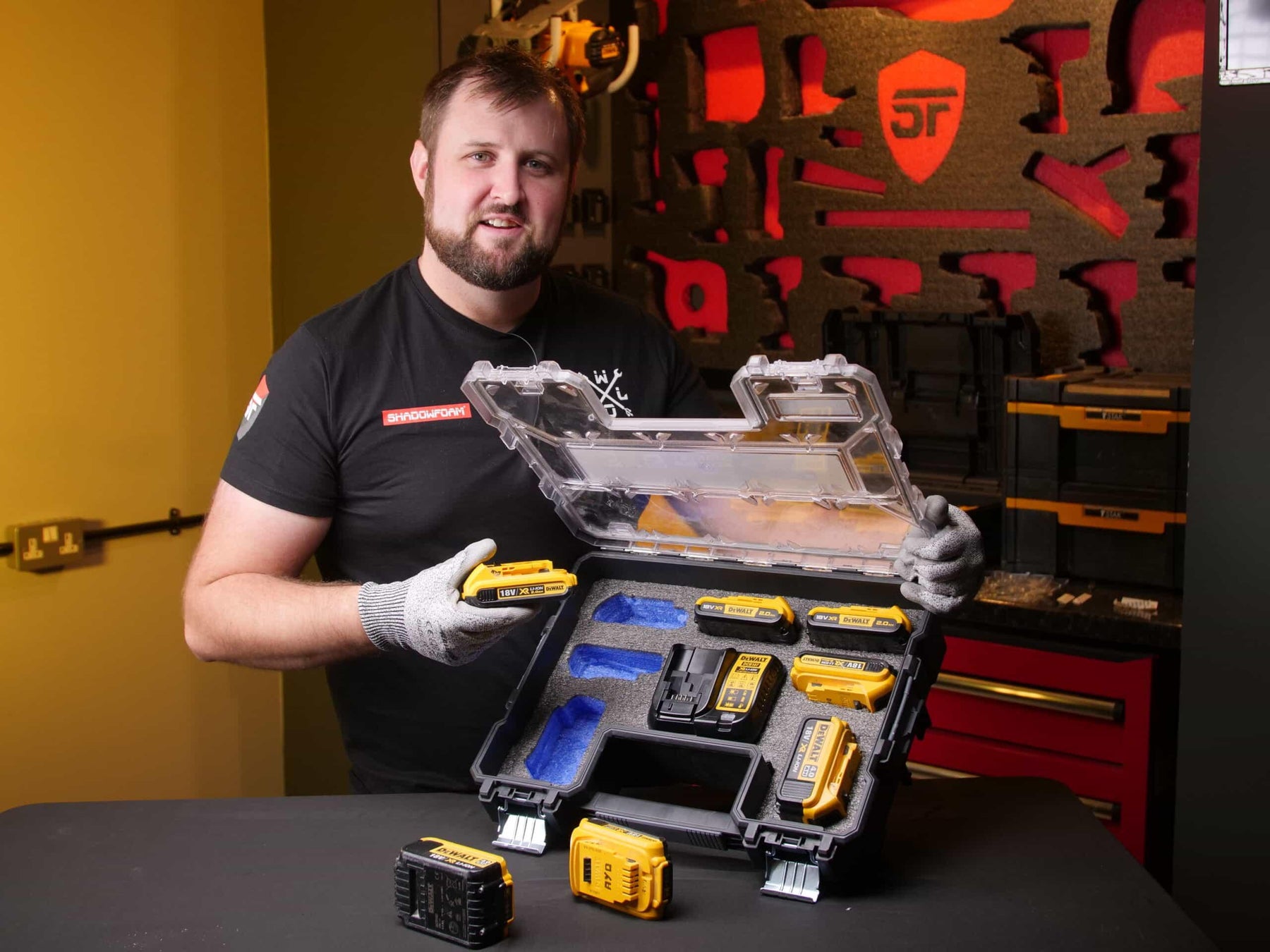Clôture quotidienne des commandes à 14h

Étui de rangement portable pour batterie Pro organiser
Les piles qui se baladent dans une boîte à outils ne sont pas idéales, non seulement parce qu'elles peuvent heurter tout, mais des piles endommagées peuvent être dangereuses ! Nous avons pensé que la meilleure façon de les protéger est avec un Insert en Shadow Foam. Pour montrer comment, nous avons utilisé un DeWalt / Stanley Fatmax Deep Pro Organiser pour organiser un ensemble de batteries d'outils électriques DeWalt. Nous pensons que l'organisateur de batteries que nous créons est un excellent moyen d'emporter toutes vos batteries hors du site à la fin de la journée. De plus, avec votre nouveau protecteur de batterie portable, vous saurez si l'une d'elles manque d'un simple coup d'œil.

Choisir le Pro Organiser comme notre étui de stockage de batterie
Stanley et DeWalt vendent tous deux cette mallette. Elle est vraiment durable, a un bon joint solide, et fait partie d'un système qui s'emboîte comme le TSTAK. Pour cette raison, nous pensons qu'elle est idéale car elle a une poignée solide et est suffisamment petite pour simplement emporter des batteries hors du site à la fin de la journée pour les recharger. La capacité d'y attacher une autre unité la rend également à l'épreuve du temps, car si vous ajoutez plus de batteries au fil du temps, elles peuvent toutes être conservées ensemble. En standard, elle est livrée avec de nombreux petits plateaux en plastique, ou compartiments dans lesquels vous pourriez normalement vouloir ranger des vis ou des embouts. Pour notre utilisation en tant que mallette de stockage de batteries, nous n'en avons pas besoin, donc nous les retirerons et les remplacerons par l'un de nos inserts en mousse.
Nos inserts sont prêts à s'adapter au Pro Organiser et sont disponibles dans un paquet jumeau avec un choix de couleurs et soit en 30mm soit en 50mm de profondeur. Pour ce cas, nous avons opté pour une feuille de 50mm en Blue. Yellow et Black iraient bien avec le boîtier et les batteries, mais nous voulons que cela soit vraiment évident si quelque chose manque, au premier coup d'œil, donc le blue le fait bien.
Créez la disposition de votre organiseur de batteries
Tout d'abord, comme toujours, il est important de planifier la disposition. Faites cela de la manière qui vous convient le mieux. Pour nous, afin de créer une unité de batterie portable, nous voulions inclure un chargeur qui peut être utilisé sur place ou retiré pour la charge. Et nous avons 2 des plus grandes batteries de 4 ampères et 5 des plus petites batteries de 2 ampères, ce qui, pour nous, est toute l'énergie dont nous avons probablement besoin. D'autres variations que nous voyons sur ce type de boîtier pourraient également inclure quelques petits compartiments en plastique que nous avons retirés afin que vous puissiez les découper dans la mousse pour ranger des petites pièces également, mais nous n'en avons pas vraiment besoin dans notre cas.
Nous avons veillé à ce qu'il y ait un bel espace de 10 mm entre les articles et les bords, et la disposition nous semble bonne. Vous voudrez peut-être prendre une photo pour vous rappeler de la disposition pendant que vous travaillez. Et ensuite, il est temps de couper !
Découper la mousse pour votre étui de rangement de batterie
Nous envoyons un pack de découpe gratuit avec toutes les commandes du site web de plus de 50 £ et celles-ci contiennent un scalpel et 5 lames. Nous recommandons vivement de porter des gants de protection anti-coupure lors de la manipulation de ces lames également et vous pouvez les obtenir dans notre kits de découpe. Ceux-ci sont vraiment rentables à acheter et si vous achetez de la mousse, vous pouvez les obtenir chez nous à moitié prix, donc cela vaut vraiment la peine d'ajouter ce kit aussi si vous le pouvez.
Appliquez une légère pression sur l'article pour qu'il ne bouge pas, puis en tenant le scalpel comme un crayon, commencer à couper. Assurez-vous de garder le scalpel perpendiculaire à la mousse et de tracer la coupe tout autour jusqu'à ce que vous reveniez au point de départ. Ensuite, vous pouvez retirer la batterie et couper jusqu'à la profondeur souhaitée. Pour nous, comme la mousse fait 50 mm et que nous voulons conserver 10 mm à la base pour donner de la force et de l'intégrité à la mousse, cela fera 40 mm.
Une fois que vous avez coupé à la profondeur souhaitée, il est temps de écorce. Commencez simplement dans un coin où vous avez coupé et enfoncez vos doigts. L'action consiste presque à labourer la mousse avec vos doigts, en l'écartant au fur et à mesure. Une fois que vous avez terminé, il est temps de répéter ce processus avec toutes vos autres batteries ! Les batteries se placent alors confortablement dans la mousse qui agit comme un bon protecteur de batterie chaque fois que vous êtes en déplacement.
Emportez votre chargeur en déplacement ?
Pour le chargeur, nous allons adopter une approche légèrement différente. Un problème courant que les gens rencontrent en organisant leurs outils est de savoir quoi faire avec les câbles et les prises. Notre bête noire personnelle est que les câbles peuvent avoir l'air négligés lorsqu'ils sont enroulés, mais il y a aussi le facteur de dommage qui peut se produire lorsque les câbles sont enroulés à plusieurs reprises. Donc, notre solution de choix est de cacher la prise et le cordon sous l'unité de chargeur elle-même.
La méthode consiste à découper le profil du chargeur comme d'habitude, et nous sommes descendus à une profondeur de 30 mm ici, nous laissant 20 mm de profondeur de mousse en dessous dans le Stanley Fatmax Deep Pro Organiser pour jouer avec. Notre objectif sera que le chargeur se tienne un peu plus haut que ces 30 mm puisque nous savons qu'il y a suffisamment de place dans le boîtier pour le faire. Donc, dans la cavité que nous avons créée pour le chargeur, nous découpons maintenant autour de la prise. Cette fois, nous descendrons à la profondeur totale de la mousse pour nous donner un maximum de dissimulation. Une fois que vous avez défini la forme de la prise, vous pouvez également découper une autre section dans laquelle le câble lui-même s'installera.

L'étui de protection de batterie fini.
Après la découpe, il est temps de remettre l'insert dans le boîtier et de faire un essai d'ajustement. Tout dans notre boîtier s'adapte parfaitement et le couvercle du boîtier se ferme toujours avec un bon verrouillage, donc nous savons que nous avons un joint étanche. Nous pensons que c'est la solution idéale de boîtier de stockage de batterie portable pour vous garder organisé et prêt à tout.




















 Kit de découpe gratuit sur les commandes qualifiées
Kit de découpe gratuit sur les commandes qualifiées
 Plus de 3 000 avis positifs
Plus de 3 000 avis positifs
 Plus de 500 vidéos sur YouTube
Plus de 500 vidéos sur YouTube
 Soutien basé au Royaume-Uni
Soutien basé au Royaume-Uni